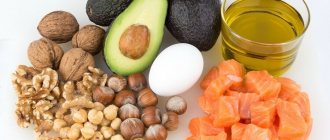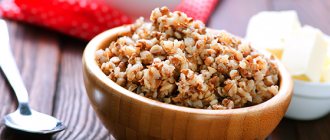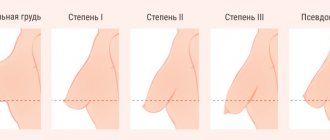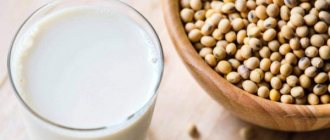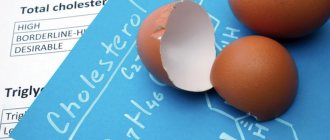There are different types of fats. Species and types
Fats are necessary for the body - that's a fact. The functioning of the endocrine and cardiovascular systems depends on them, but not all fats coming from food are equally healthy and necessary.
Everyone knows that they are divided into animal and vegetable, and there are also liquid and solid. Let's delve a little deeper into the structure of matter and understand where this difference comes from.
Any fat is a mixture of saturated and unsaturated fatty acids. An acid consists of a carbon chain surrounded by hydrogen atoms. So, if a molecule is completely covered with hydrogen atoms, such an acid is called saturated, respectively, if there are not enough of them, it is called unsaturated.
Solid fat is a mixture of acids, most of which are saturated. These fats include animal fats. They are represented by products such as butter and lard.
In liquid fat, unsaturated acids occupy a larger volume. Examples of such a product are all vegetable oils and some animal fats, such as fish.
As you can see, the molecular composition determines the physical properties. Liquid oils with a predominance of unsaturated acids are fluid and have a low melting point. Solids are dense and melt at higher temperatures.
Another type of fat may be found in products - hydrogenated. It is used as a substitute for expensive milk fat. This is a substance of artificial origin, which is obtained mainly from cheap vegetable oils. Under the influence of high temperatures and chemical catalysts, unsaturated acids obtain the missing hydrogen, and liquid fat turns into solid fat, with all its inherent physical properties.
In the food industry, the production of hydrogenated fats, or fats as they are also called, is of great importance. Agriculture is unable to fully satisfy the needs of processing enterprises for animal fats. Therefore, artificial analogues are often used instead.
How to choose frying oil
“Although frying is not the healthiest cooking method, most housewives fry almost every day. It is important to minimize the harmful components of the oil,” explains Medvedev. — The best option for this is to fry in vegetable oils with a high smoke point (see table). And for salad, keep separate oils - unrefined. For example, pumpkin, cold-pressed olive (Extra Virgin) or our camelina.”
Some people think that such unrefined oils are good for frying. It's not like that at all. The taste and aroma of unrefined oils is good in salad. And when they are used for cooking at high temperatures, vitamins and antioxidants are destroyed: they form toxic compounds that are harmful to health. Plus, unrefined oils give fried foods a specific taste and smell that many people don’t like. Therefore, it is better to use refined vegetable oil for frying. It has a neutral smell and taste, it is cleared of all impurities.
Each oil has its own smoke point at which it begins to smoke and burn. After passing the smoke point, the oil becomes harmful to health: in addition to the unpleasant taste and smell, carcinogens are formed in it. For frying, you need to use oil with a smoke point above 160 degrees: it is this temperature that is created in the frying pan during cooking, which creates an appetizing golden crust on the food. For deep frying, you will need oil with a smoke point above 180 degrees. Regular refined sunflower oil is suitable for all types of frying: its smoke point is 232 degrees. Olive, corn and coconut oils are also suitable for frying (a more complete list of oils is given in the table).
If you like to spread butter on your bread, choose a healthy spread that contains more healthy unsaturated fats than saturated fats.”
What are trans fats?
Trans fats are by-products formed as a result of the hydrogenation reaction during the production of lard. When liquid fat is saturated with hydrogen, not all of its molecules acquire the missing atoms. Some of them change their spatial structure, turning into dangerous compounds.
That is, they may not accept hydrogen, but change shape, turning any of their parts in the other direction. And then we can already talk about the appearance of a trans isomer - a substance of a similar composition, but a different structure.
You can often come across another name - “transgenic fats”, but it is not correct. Since here we are not talking about the genome, but only about the structure of the molecule.
Trans fats are spatial isomers of fatty acids, the normal molecules that make up natural fats. Only they have completely different properties, and cannot be called useful in any way.
Trans fats are present in small amounts in natural oils. They are formed as a result of the activity of bacteria inhabiting the stomach of ruminants. Partially passes into meat and milk. From there they get into the product.
In solid milk fat their content ranges from 2 to 8%. While in hydrogenated oils obtained industrially, their share can increase to 67%. It is worth noting that trans fats obtained artificially and naturally have completely different properties.
The harm of trans fats
Trans isomers of fatty acids, absorbed through the intestinal walls and entering the bloodstream, are embedded in the structure of the cell membrane. However, being a “foreign” component, the trans fat molecule disrupts the protective and metabolic function of the cell membrane, which leads to various negative consequences. Cells with membranes in which polyunsaturated fatty acids are replaced by trans isomers become more vulnerable to various negative effects. Such membranes lose their ability to actively remove toxic waste products from the cell, leading to self-poisoning. The reverse process is also observed: beneficial substances do not enter the cell, and therefore the cell gradually dies due to energy starvation.
Scientific research in recent years has proven that trans isomers of fatty acids are the cause of the development of many diseases, the most dangerous of which are ischemic disease, atherosclerosis, type 2 diabetes mellitus (non-insulin dependent), obesity, hypertriglyceridemia (increased fat content in the blood), fatty liver, demyelinating diseases of the nervous system (multiple sclerosis), etc. Trans fats dramatically increase the risk of developing cancer, especially breast cancer. Thus, it was found that women whose diet contained large quantities of trans fats had a 40% higher incidence of breast cancer. Numerous scientific studies have also proven that trans fats cause an increase in the blood levels of low-density lipoproteins and very low-density lipoproteins (“bad” cholesterol) and a decrease in high-density lipoproteins (“good” cholesterol). It is this fact that explains the progression of the increase in the incidence of atherosclerosis, especially at a young age.
Showing concern for public health, many European countries strictly regulate the content of trans fats in a particular product. In 2003, Denmark established a permissible limit for the content of trans fats in products of no more than 2%. Restrictions have also been introduced in America. By order of the Department of Health, the content of trans fats in one dish is limited to 0.5 g. In many European countries, a trans fat content of 2 to 5% is considered acceptable. According to Russian legislation, the norm for trans fats is slightly higher - up to 8%.
So far in Russia there are no legal regulations obliging manufacturers to indicate the content of trans fats on packaging, so you should try to avoid purchasing products that contain them.
History of appearance in nutrition
In the 1890s, the future Nobel laureate P. Sabatier decided to put the hydrogenation reaction into practice. We all already know what came of it. In our country, the first attempt to harden liquid fats was made by the scientist S. Fokin in 1906.
But the German researcher V. Normann went further. He created industrial equipment that made it possible to obtain solid fats from liquid oils, and in 1909 he patented his own production technology. In 1911, he sold his patent to a company that put Procter and Gamble's experience into practice. She created a first-of-its-kind product, a dough improver based on hydrogenated cottonseed oil.
Hardening of fats has found wide application in the food industry. Hydrogenated oils began to be added to foods and semi-finished products to maintain structure and preserve their appearance. Artificial fat, compared to natural fat, has a higher melting point and does not melt outside the refrigerator. It tastes like butter, so it can significantly “ennoble” the product.
Hydrogenation began to be used for more mundane purposes. Thanks to it, the shelf life of perishable products has increased. Since solid fat contains fewer unsaturated molecules, it is difficult to oxidize and therefore does not spoil for a long time. Hydrogenation was used to preserve valuable products such as whale oil.
The health risks of trans fats
It seemed, well, what’s wrong with that, well, there’s an ugly, irregular fatty acid molecule in the body, so what? The thing is that each cell is surrounded by lipids consisting of fatty acids. These lipid molecules protect the cell from external influences and ensure its interaction with other cells, nutrients, and oxygen.
The human body has an organ system whose damage leads to damage to many parts of the body and death. We are talking about the cardiovascular system. More precisely about the vessels themselves.
There are two types of vessels: veins and arteries. Oxygen-poor blood flows through the veins from the organs; it flows passively to the heart. And from the heart, blood flows actively through the arteries, pushed out by the heart muscle.
Arteries are more complex. On their inner surface there are special endothelial cells. These cells are very sensitive to damage and upon contact with a foreign particle, the arteries sharply narrow their lumen with the help of a layer of muscle cells, turbulent blood flow occurs, and blood clots develop.
These are, of course, not large particles, but the worst thing is that red blood cells stick to the microscopic clot and the clot grows. As a result of the fact that trans fats change the structure and structure of the blood vessels themselves, they are able to increase the amount of high molecular weight heavy cholesterol, which subsequently constitutes the structural unit of atherosclerosis.
Hence a number of diseases of vascular origin:
- Coronary heart disease is a group of diseases that are based on only one phenomenon, insufficient supply of oxygen and nutrients to the myocardium. Myocardium is the heart muscle. When a muscle can no longer cope with the load, structural changes occur in it, and this further aggravates the process. If a vessel is completely blocked and blood does not flow to the heart cells at all, myocardial infarction occurs.
- Stroke is a generalized name for a group of cerebrovascular diseases. Just like the blood vessels in the heart become damaged in the brain and stop delivering oxygen and nutrients to the brain cells.
- Ischemic damage to the blood vessels of the legs and arms. Sometimes, when the vessels are so narrowed by atherosclerotic plaques, and the wall itself loses its elasticity and becomes brittle, the small capillaries of the fingers and toes become clogged, and the fingertips turn black - this is the so-called dry gangrene.
- With a long course of coronary artery disease, they talk about angina pectoris. In this case, the person cannot perform physical activity or walk long distances.
How dangerous are trans fats for the human body?
Trans fats have the ability to replace lipids that are part of the cell membrane, disrupting its structure. The affected cell loses the ability to fully feed and remove harmful substances. Subsequently, it ceases to perform its function. When there are many such cells, it begins to affect the functioning of an organ or even an entire system.
Consumption of trans fats leads to metabolic disorders and the accumulation of toxins.
All this can be the cause of any disease.
The answer to the question “How to remove trans fats from the body?” can be answered immediately – no way. They do not appear on their own. Their disposal is possible only together with the affected cells. All tissues of our body are constantly renewed. Some cells die, others appear. It is only through this process that the body is cleansed over time, provided that dangerous isomers do not enter it again.
"Wrong" milk?
Why can’t you make yogurt or cottage cheese from the milk that is now sold in the store? It doesn't turn sour, but goes rancid! I’ve already heard from several people that antibiotics are added to it to make it “long-lasting.”
Polina Melnikova, Moscow
Dairy industry technologist Alla Maltseva answers:
Article on the topic
Gene mutations are responsible for baldness, obesity and the ability to digest milk
– Just because milk goes rancid does not mean it contains antibiotics. Adding them is prohibited by law. And if sick cows receive medications, then, in accordance with sanitary rules, their milk must be disposed of within 5–10 days (depending on what drug is used). After all, antibiotics that pass into milk from an animal’s body can affect our microflora and cause resistance (resistance) to drugs.
But why does milk still go rancid, which has never happened before? The fact is that during sterilization all lactic acid bacteria are killed in it. Therefore, it is best to buy not sterilized milk, but pasteurized milk. And after opening the package, use it within 24 hours. And if you want to get homemade yogurt, you need to add a special starter to the milk.
What diseases can transgenic fats cause?
In the 1990s, publications began to appear on the impact of trans fats. It was found that consuming products containing such components primarily negatively affects the functioning of the heart and blood vessels.
Trans fats disrupt the balance between “bad” and “good” cholesterol. This equilibrium shifts towards heavy molecules. They are capable of forming conglomerates, which subsequently adhere to the walls of blood vessels and narrow their lumen.
With the accumulation of “bad” cholesterol in the body, the risk of:
- heart attack;
- stroke;
- coronary heart disease;
- atherosclerosis;
- diabetes;
- obesity.
It has been established that in the United States more than 20,000 deaths per year are registered due to diseases caused by eating trans fats.
Some studies show that the presence of these components in the body of the expectant mother can provoke mutations in the fetal genome.
As is known, sex hormones are formed from low molecular weight cholesterol. A shift in balance towards large molecules leads to disruption of the reproductive system, which can ultimately result in infertility.
The accumulation of carcinogens in the body increases the risk of developing cancer, Alzheimer's disease, and depression.
Diet for a long life
One of the most popular theories of aging, the telomeric theory, suggests that a person’s lifespan depends on the length of the cell’s telomeres, which are located in the “tail” of DNA. Some people naturally have long telomeres, while others are unlucky - they are genetically predetermined to have short telomeres. Previously, it was believed that nothing could be done about this, but recent research by scientists is encouraging: as it turned out, each of us can increase the length of telomeres. Also, however, how to shorten it. It all depends on what you eat...
Lengthen telomeres
Every person ages, but everyone ages differently. Some people look like wrecks even at thirty, while others still look great even at seventy. What does this depend on? Scientists have been struggling with this question for a long time. And one of the main theories of aging today is associated with telomeres - the ends of DNA that perform a protective function in the cell and which are called the main biomarkers of the aging process.
Eight years ago, a group of researchers who proved the link between DNA telomere length and life expectancy received the Nobel Peace Prize in Medicine. Today we know that telomeres shorten over the course of life. This is why, scientists suggest, the body begins to decay.
And yet, telomere length can be controlled - this is the conclusion that American gerontologists from Duke University came to based on their long-term research. It focused on a group of volunteers who were 26 years old at the start of the experiment. Scientists examined all their basic indicators of health and physiological development, and after 12 years they checked what had changed. As it turned out, for the majority of participants in the experiment, the biological age was noticeably different from the actual one - both up and down. As a result, scientists came to the conclusion that the intensity of the aging process depends on genetics by no more than 20%. Everything else is determined by lifestyle: how active and mobile a person is, how often he is exposed to stress and, most importantly, how and what he eats.
It is necessary to engage in the prevention of aging from early youth, American scientists have proven this in their research, says professor of Moscow State University. Lomonosov, headed by the Scientific Research Oleg Medvedev. – Therefore, the earlier a person begins to lead a healthy lifestyle, the greater his chances of living a long active life. And even if in youth you constantly eat chips and wash them down with soda, this will cause irreversible damage to the DNA structure and shortening of telomeres.
Menu "accelerated aging"
Professor Medvedev emphasizes that aging ahead of time can be caused, first of all, by the abundance of trans fats in the diet, as well as saturated fats of animal origin. Even the World Health Organization has already recognized trans fats as the most harmful component of food. Meanwhile, they are contained in many industrial products - semi-finished meat products, confectionery products, fatty sauces, fast food, sweets, etc. Their regular use, as proven by many studies, provokes the appearance and development of various types of old age diseases - cardiovascular, cancer , Alzheimer's disease, Parkinson's disease, diabetes mellitus, etc.
In addition, the researchers included sugar, meat (primarily red meat) and refined flour in the anti-rating of foods that lead to accelerated aging.
Proper nutrition to maintain youth
But there are, of course, products whose benefits are obvious, and whose positive effect on the length of cellular telomeres and life expectancy in general has now been proven.
First of all, these are foods with a large amount of antioxidants - berries, fruits, vegetables, herbs. The fact is that cellular telomeres mainly consist of guanine, a substance that is destroyed under the influence of free radicals, which antioxidants fight in the body.
Scientists put seeds and nuts in second place. The secret is that the dense seed coat, as it turned out, protects from destruction not only plant cells from the action of free radicals, but also our telomeres. That's not all. It is known that nuts and seeds are rich in unsaturated fats, which, in turn, can partially neutralize the harm caused to the body by saturated fats.
In third place are products rich in polyunsaturated fatty acids omega-3 and omega-6. First of all, these are fatty sea fish, seafood, and avocados. Scientists call them “foods of longevity.”
An important conclusion of scientists is that you don’t need to consume these beneficial reducers separately, but create a balanced diet that includes a sufficient amount of healthy fats, protein, and complex carbohydrates. Once again, a well-known fact has been confirmed - the best diet for increasing life expectancy is the Mediterranean diet. It is now clear that it can be used to lengthen cellular telomeres.
Well, in the top of the most useful foods that prolong telomerization, scientists included bananas (they protect our heart and blood vessels due to the large amount of potassium), raspberries (they ensure the processes of cell division), oranges and other citrus fruits, as well as pomegranates and kiwi ( they are full of vitamin C, which not only strengthens the immune system, but also improves memory and protects against the development of senile dementia), as well as blueberries. Scientists suggest replacing live dairy products with avocados (to reduce the risk of developing heart and vascular diseases). You also need to eat as many tomatoes as possible - the lycopene they contain prolongs youth and ensures the prevention of cancer.
And, of course, to be faithful to proper nutrition, it is worth adding physical activity and giving up bad habits - and then old age will not come for a long time, and when it comes, it will be a joy.
Correlation with obesity
There is an indirect link between excessive consumption of trans fats and obesity. Against the background of cholesterol imbalance, changes occur in the endocrine system. Due to a lack of hormones, the process of lipid utilization is inhibited. Fats begin to be deposited in tissues, which can subsequently lead to obesity.
According to WHO, the number of overweight people has doubled over the past 20 years, and trans fats play an important role in these statistics.
Trans fats and obesity
There is a correlation between uncontrolled weight gain in the population and the consumption of trans fats in food.
If cholesterol metabolism is disrupted, the normal functioning of the endocrine system is disrupted. In this case, the regulation of lipid metabolism suffers first of all. Lipids break down more slowly and are increasingly deposited in tissues.
More sad statistics say that the percentage of obesity among children has also increased several times. This can be explained by the wide distribution of various kinds of snacks, chips and other harmful things.
Television and radio advertising promotes food chains that use hydrogenated fats in all their dishes. Poor eating habits are instilled in children from an early age, and this leads to obesity and loss of health.
Trans fats and modern children
Modern children spend more and more time outside the home. This directly affects their eating behavior. With this lifestyle, snacking on the go between classes becomes the norm. To compensate for the lack of energy, the child subconsciously strives to eat something high in calories. Advertising also plays a role. Instead of healthy food, he chooses snacks, sweet bars or fast food.
Most of what is sold in fast food restaurants contains hydrogenated oils, and along with them, trans fats. Fast food not only satisfies the need for food, but also causes irreparable harm to health.
Most of the snacks that children love so much: puffed corn, chips, quick breakfasts are replete with trans fats. You need to fight unhealthy eating behavior, first of all, by eradicating the habit of eating on the go.
Permissible norm of trans fats for humans
For an ordinary person, the permissible intake of trans fats is no more than 3 g per day. If you eat 4 g, then this is already fraught with unpleasant health consequences. There is no minimum safe dose. It is best to exclude this product from the diet completely.
In order to completely cleanse the human body of harmful substances, it is necessary to follow a diet and eat properly for two years.
In European countries, the production and sale of products containing more than 2% trans fats is prohibited. More advanced production technologies make it possible to reduce the amount of substances to a minimum.
To avoid excessive consumption of trans fats, you should follow simple rules:
- eat only homemade desserts;
- exclude fast food from the menu;
- carefully study the composition of the product before purchasing;
- in the process of cooking, foods should be stewed, baked, boiled or steamed;
- do not use margarine for cooking;
- do not buy ready-made food;
- Avoid frying and deep-frying food.
If you consume only fresh foods of natural origin, you can avoid oversaturation of the body with trans fats. You should also replace store-bought sauces with homemade ones. You can use unrefined, cold-pressed vegetable oil as a salad dressing. A quick snack can be successfully replaced with nuts and dried fruits. Cereals and nuts contain vitamin E, which promotes the absorption of fats. Your daily diet should contain vegetable oils that can maintain energy balance.
List of foods containing trans fats:
We remind you that trans fats can be found in small amounts in natural products, but in natural oils they have a completely different composition. There are a huge number of trans isomers, but the effect on the body of only some of them has been studied.
The largest amount of harmful oils is found in hard margarines and cooking fat. There their share reaches from 18 to 67%. Below is a list of foods containing trans fats. Once you've read it, you'll have a better idea of what it's all about.
Trans fats in butter
In natural butter, made exclusively from dairy cream, the content of natural trans isomers is in the range of 1.6-6.8%. These are non-artificial trans fats; their effect does not have a detrimental effect on the body.
It is worth paying attention to the labels on the packaging. The product must be called “butter”, consist of dairy cream and have a fat content of 78 to 82%.
Trans fats in vegetable oils
Refined vegetable oil contains less than 1% natural trans fats, the consumption of which is also not dangerous. These oils are useful to consume fresh, adding to salads.
Trans fats in margarine
This category includes the most dangerous products, in which the content of trans fats is particularly high. Most confectionery products (cookies, waffles, cakes, rolls, sweets, etc.) are prepared on the basis of margarines.
On the labels of such products it may be referred to as:
- cooking fat;
- milk fat substitute;
- hydrogenated fat;
- Palm oil;
- mixture of vegetable oils;
- spread
For home use, instead of margarine, it is better to purchase refined vegetable oil for frying, ghee or butter for baking.
Trans fats in mayonnaise
Natural vegetable oil in mayonnaise and any other industrial sauces can be partially or completely replaced with hydrogenated oil, which will provide the product with a long shelf life.
Trans fats in chocolate
In sweet bars, expensive cocoa butter is replaced with low-quality hydrogenated fat to reduce the cost of the product. It also increases the melting point of the tile, preventing it from melting in the heat.
The expression “melts in your mouth, not in your hands” has nothing to do with good chocolate. The real thing should melt in your hands.
"Fast food"
Any semi-finished products are prepared using hardened fats containing trans isomers. Even seemingly simple burger buns are actually not so harmless. As evidence, we can cite the fact that they can be stored for six months. And all thanks to the “nuclear” composition.
Semi-finished meat products and sauces are also protected from spoilage and loss of appearance due to the inclusion of hydrogenated fats.
Deep fried products
Trans fats are formed as a result of frying food in low-quality, unrefined vegetable oil. The harm increases significantly if the frying fat is not changed on time.
Fast food restaurants offer dishes from this category such as:
- French fries;
- donuts;
- nuggets;
- fish fingers;
- deep-fried squid rings.
Other products
What foods contain trans fats besides those listed above? Roasted peanuts and puffed corn can be considered unhealthy foods. Solid vegetable fats are present in sausages, semi-finished products, and ready-made frozen meals.
Where are trans fats found?
Trans fats are considered so harmful that in 2021, the US Food and Drug Administration (FDA) finally banned their addition to food products. Final Determination Regarding Partially Hydrogenated Oils (Removing Trans Fat).
So Americans can feel more or less protected. Nevertheless, they, and even more so residents of other countries, are strongly recommended to reconsider their diet. And refuse Trans fat is double trouble for your heart health from the following products:
- store baked goods - cakes, buns, pies;
- fast food, including donuts, French fries and breaded or fried chicken and seafood;
- store-bought popcorn;
- frozen dough products, including frozen pizza;
- dairy-free coffee creamer;
- ready-made glazes for cakes and pastries.
This list is far from complete. To check how safe a product is, look at its label. It definitely contains trans fats if the list of ingredients contains:
- hydrogenated oil;
- partially hydrogenated oil;
- margarine;
- vegetable fat;
- cooking fat.
Why are trans fats still used?
It is more correct to say that they do not use trans fats, but hydrogenated fats, since trans isomers are only a by-product of their production. Industrial enterprises do not set out to obtain trans fats. They make solid fats from liquid ones, but due to the low quality of the raw materials, a large number of harmful impurities are formed.
The modern food industry is unlikely to be able to abandon hydrogenated fats. There is a great need for them. These fats cannot be replaced with the same amount of natural solid oils.
There are economic benefits to using margarines. Products with them last longer, keep their shape better, and are cheaper. Therefore, we can only hope that industrialists will begin to take a more careful approach to the selection of raw materials for the production of artificial fats.
Since the 2000s, Europe has been actively fighting the content of trans fats in products at the state level. They are completely prohibited in countries such as Austria, Hungary, Denmark, Switzerland, and Iceland. Europe is gradually moving towards eliminating the use of partially hydrogenated vegetable oils in products, which contain the most dangerous isomers.
In our country there is a GOST, according to which the share of harmful components in solid fats should be limited to 8%. But with the formation of the Customs Union, this document lost its binding nature, since neighboring countries are not ready to fulfill this condition due to the low technical equipment of their food enterprises.
Trans fats of animal origin
In the rumen of ruminants, the process of fat biosynthesis occurs due to bacteria and specific enzymes. In this regard, it is necessary to control the consumption of beef, lamb, butter, full-fat milk, cheese, and ice cream, as they contain trans fats that damage cell membranes. Thus, butter contains 4-8% trans fats, and in the summer this figure can reach 11%, which is almost one and a half times higher than the permissible limit established for spreads.
In this regard, it is necessary to replace such fats as much as possible with vegetable ones. They are not recommended to be subjected to heat treatment. Eating vegetables is mandatory, as they are necessary to protect the vascular walls. It is best to use olive, mustard, and linseed oil for cooking. Fruits and vegetables should be present in the diet daily. Also, to preserve the beneficial polyunsaturated fatty acids entering the body, it is necessary to consume oatmeal and brown rice, which contain ascorbic acid, which protects the body from free radicals that can damage “healthy” fatty acids.
How to reduce your trans fat intake?
To do this, it is necessary to minimize the consumption of ready-made and industrially processed food. Buy fresh, raw, natural foods and cook them yourself.
Heating vegetable oil can also create trans fats. Therefore, it is better to replace such a method of culinary processing of foods as frying with stewing, boiling and baking.
Let's say no to trans fats
The World Health Organization recommends reducing the amount of trans fat in our food to 1% or even zero. Unfortunately, not all states heed this advice. For example, if a serving of French fries in a fast food cafe in Holland “gives” us only 4% trans fats, then in America this figure will increase to 21%.
By the way, it is worth noting that natural trans fats do exist - in dairy products and meat. That is why the consumption of artificial trans fats should be avoided completely - we will get the coveted 1% that WHO talks about with natural food.
Value your health and love yourself - let the “bad guys” stand aside and not interfere in your life.
